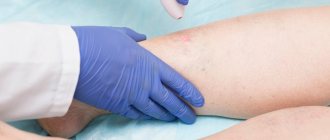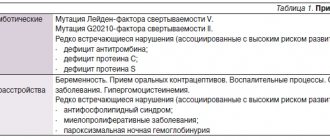Crossectomy is a surgical vascular operation on the veins of the lower extremities, during which the large saphenous vein and its smaller branches are ligated. A similar operation (crossectomy, synonymous with the Troyanov-Trendelenburg operation) allows you to eliminate the saphenofemoral anastomosis - the place where the great saphenous vein flows into the deep femoral vein.
This surgical intervention is most often used for emergency indications, but it can also be planned. Crossectomy is a quick, low-traumatic and sometimes the only method that phlebologists at the Yusupov Hospital use when there is a threat of thrombosis of the ileofemoral segment of the ascending venous collectors.
Crossectomy: indications for performance
Crossectomy (Troyanov-Trendelenburg venectomy) may be recommended for patients at the Yusupov Hospital Therapy Clinic for the following diseases:
- in acute thrombophlebitis with a steadily ascending nature of thrombosis;
- with purulent thrombophlebitis, panphlebitis of various localizations (in the knee, femoral segment and above);
- with forms of thrombophlebitis resistant to antibacterial drugs (with immunodeficiency).
Thus, crossectomy is used for acute thrombophlebitis, i.e. complicated course of varicose veins.
How is the operation performed?
Before the intervention begins, the patient is placed on the operating table. To avoid severe bleeding during the course of action, the body is bent at the knee area. Moreover, the doctor will ensure that the head and feet are at the lowest point of the inclination at approximately the same level.
In surgery, over the years, a certain course of crossectomy has been developed, which is strictly observed.
- First, disinfection of the skin in the affected area is required, after which the surgical field is covered with sterile linen.
- Now the doctor needs to find the location of the femoral artery using the pulse and use it to determine the location of the great saphenous vein. A small incision no longer than 4 cm is made above the latter.
- By spreading the layers of subcutaneous tissue, the surgeon provides access to the place where the internal vein flows into the femoral vein. This is where bandaging and cutting off of the blood flow occurs.
- Finally, the doctor needs to identify the vessels flowing into the great saphenous vein in order to ligate and cut them off. Now the intervention site needs to be sutured in layers, and a sterile bandage applied on top.
Crossectomy: contraindications
Contraindications to this surgical intervention can be either absolute or relative.
Crossectomy (Troyanov-Trendelenburg operation) is absolutely contraindicated in the following diseases and conditions:
- oncological diseases;
- severe obesity;
- diabetic nephropathy, signs of diabetic foot;
- multiple organ failure;
- severe atherosclerosis;
- cachexia;
- in old and senile age.
- Crossectomy is relatively contraindicated in the following cases:
- with trophic disorders on the operated lower limb;
- in case of limited mobility of the patient in the postoperative period;
- in the absence of the possibility of providing round-the-clock compression in the postoperative period.
Indications and contraindications
Previously, varicose veins were considered a disease that exclusively affected older people. Unfortunately, today the situation has changed significantly. Varicose veins are getting younger every day, and are now found even in teenagers.
Crossectomy is indicated in the following cases:
- The presence of thrombophlebitis of the lower extremities;
- Too frequent relapses of inflammation of the vein walls;
- Lack of positive effect from drug treatment;
- Thrombophlebitis in the area of the knee joint and above.
We can conclude that surgery is required for serious complications of varicose veins. Alas, even surgery does not guarantee a complete recovery. Stable remission can only be achieved with further comprehensive treatment.
Crossectomy of the veins of the lower extremities: preoperative preparation
Before performing a crossectomy, patients at the Yusupov Hospital Therapy Clinic undergo a comprehensive medical examination, based on the results of which phlebologists can identify possible contraindications. Diagnostics are performed using modern equipment from leading medical equipment manufacturers. The condition of the lower extremities is assessed using ultrasound. An integrated approach is used: patients are prescribed consultations with specialized specialists (therapists, cardiologists, angiosurgeons), laboratory tests, an electrocardiogram is taken, etc.
Immediately before surgery, patients should not eat or drink plenty of fluids.
Surgical combined phlebectomy, why the technique is not ideal
Combined phlebectomy at one time made a splash, a kind of revolution both in the treatment and understanding of the pathogenesis of varicose veins. More than a century has passed since then, today milder versions of anesthesia and other surgical instruments are used, but no fundamental changes have occurred in this surgical technique. Even with the advent of innovations in the form of: PIN stripping, intussusception stripping and cryostripping, the technique essentially remained the same.
Cryostripping - removal of varicose veins with cold
Classic combined phlebectomy using a Babcock probe still remains the most widespread for the treatment of varicose veins in the public sector of medicine due to the unobvious advantages of the above innovations.
Crossectomy of the veins of the lower extremities: progress of the operation
Crossectomy is performed slightly differently than the Troyanov-Trendelenburg operation. The technique of these surgical interventions has some differences. The Troyanov-Trendelenburg operation consists of intersecting the great saphenous vein 10-15 cm below the saphenofemoral anastomosis, or more distally. After such a surgical intervention, relapses are often observed, since blood flow is often gradually restored.
During crossectomy, the vein is ligated much higher: almost directly at the junction of the great saphenous vein with the femoral vein. This ensures the separation of superficial and deep blood flows and prevents relapses.
Vein ligation does not require general anesthesia. Only local (conduction) anesthesia is used, which is an advantage of the Troyanov-Trendelenburg operation (crossectomy). The progress of the operation is monitored by experienced phlebologist surgeons at the Yusupov Hospital.
Crossectomy is carried out in several stages:
- treatment of the surgical field;
- a skin incision in the groin area, subcutaneous tissue, high isolation of the saphenous vein near the place of its confluence;
- ligation of the great saphenous vein along with its tributaries at a distance of about one centimeter from the sapheno-femoral junction;
- suturing.
Thus, the saphenous vein is not removed during crossectomy, which is understandable since, as a rule, this operation is an emergency.
Therefore, there is no need for special preparation for surgical intervention, unlike combined phlebectomy. Patients do not have their limbs shaved, and there is no need for a cleansing enema, since general anesthesia is not used.
Preparing for surgery
Before surgery, you will need to undergo a standard clinical minimum of diagnostic tests:
- General blood and urine analysis;
- Blood chemistry;
- Tests for RW, hepatitis B and C, HIV;
- Coagulogram; ECG;
- Fluorography.
You will have to choose compression hosiery for yourself in advance on the recommendation of your treating phlebologist. Immediately before the operation, you should shave the hairs at the site of the manipulation. If general anesthesia is expected, you should not eat or drink on the day of surgery. In the evening you should perform a cleansing enema.
Crossectomy: postoperative period
The main activities that are carried out in the postoperative period after crossectomy are aimed at preventing inflammatory and thrombotic complications that can accompany any surgical interventions performed for emergency reasons in non-ideal conditions. They include:
- rational and powerful antibacterial therapy (use of combined antibiotics: amoxiclav, cefepime, meronem) for purulent thrombophlebitis;
- correction of dysbacteriosis;
- anti-inflammatory treatment (taking non-steroidal anti-inflammatory drugs to reduce redness, heat, swelling, soreness);
- phlebotonic (venotonic) therapy with drugs that accelerate venous return and increase the tone of the venous wall: detralex, phlebodia, troxerutin. In addition, certain venotonics have a lymphotropic effect, which prevents lymphostasis during edema of the lower limb;
- taking painkillers - most often necessary only on the first day after surgery, since the volume of surgical intervention is insignificant;
- the use of anticoagulants (fraxiparine), disaggregants (acetylsalicylic acid), trental, pentoxifylline, dipyridamole;
- the use of wound healing agents, vitamin complexes and reparatives that help improve the condition of the skin and heal trophic ulcers;
- taking medications that increase the body’s nonspecific resistance (for patients with reduced immunity).
- In addition to drug therapy, other methods are used to promote rapid recovery after crossectomy:
- the use of compression treatment from the first day after surgery: the lower limb is tightly bandaged using hospital compression stockings, the wearing regimen of which is determined individually by phlebologists at the Yusupov Hospital for each patient;
- early onset of the patient’s physical activity: due to the small volume of the operation, the patient is recommended to begin walking already on the first day after the intervention.
What do we offer today instead of classical surgical treatment of varicose veins?
Everything changed about 20 years ago with the advent of the first successful attempts at endovasal thermoobliteration. This was a significant technological breakthrough that radically changed phlebology. The initial clinical experience with the use of thermoobliteration was on the verge of a medical experiment. Any innovative technology goes through this stage. During that period of the first steps and development of the thermoobliteration technique, one could talk about its competition with classical surgery.
Laser radial light guide
After the appearance of radial light guides for laser coagulation in 2008, there could no longer be any talk of a significant opposition between combined phlebectomy (in any form) and endovasal thermoobliteration. What are the benefits of endovascular varicose vein surgery:
- Fine manipulation control via ultrasound imaging
- Minimally invasive, only skin punctures.
- Mild anesthesia in the form of local tumescent anesthesia.
- Full outpatient service for all procedures.
- Good patient tolerance of both the manipulation and the postoperative period.
Crossectomy: disadvantages of the method
Despite its high efficiency, the crossectomy method has several serious disadvantages:
- long rehabilitation period;
- the need for mandatory hospitalization of the patient in a 24-hour hospital.
Reviews of doctors providing the service - crossectomy
I had surgery on 2 legs with Yuri Stanislavovich Malakhov.
I want to express my deep gratitude to him for a new breath of life, lightness on my feet, one might say, a completely different standard of living. Yuri Stanislavovich, you have golden hands and you are a doctor from God! I recommend it to everyone, women and men - don’t be afraid and... Read full review Irina Nikolaevna G
11.06.2021
I would like to sincerely thank the surgeon-phlebologist Yuri Stanislavovich Malakhov for the high-quality treatment of varicose veins using a modern method: no incision, no hospitalization, high cosmetic effect. The very next day I went to work. Yuri Stanislavovich is a professional... Read full review
Natalia Viktorovna F
18.04.2021
Crossectomy: postoperative complications
Crossectomy, like the Troyanov-Trendelenburg operation, is an emergency surgical intervention. In some cases (for example, with ileofemoral thrombosis), during the operation it becomes clear that the patient needs more serious measures. The operation may expand and may require the assistance of the operating team, intubation and transfer of the patient to artificial ventilation.
The following complications may occur during crossectomy:
- The great saphenous vein at its junction with the femoral vein may be damaged, which may be accompanied by severe bleeding. This most often occurs with sclerosis, thickening of the venous wall;
- the femoral artery and femoral vein may be damaged, which is a more serious complication;
- there is a possibility of developing postthrombophlebitis syndrome;
- risk of acute postoperative thrombosis of the iliofemoral segment;
- lymphatic vessels in the groin area may be damaged, resulting in lymphorrhea developing in the postoperative period;
- there is a possibility of suppuration in the groin area if there are pronounced signs of the inflammatory process during surgery.
Competent and timely performance of the operation, adherence to the regimen recommended by phlebologists at the Yusupov Hospital in the postoperative period guarantees the absence of negative consequences of crossectomy.
A complex approach
The algorithm described above is suitable for crossectomy as monotherapy for emergency situations when it is necessary to block possible complications of thrombosis immediately. But usually the operation becomes only part of an extensive phlebectomy, acting as the first step towards restoring the health of the legs. Here it is impossible to do without excision of the affected vessel.
The first step of combined radical intervention involves an inguinal incision in the area of the junction of the deep and superficial veins. The second vessel is cut off taking into account the degree of damage, and then ligated.
The second step involves making another cut at the top of the shin or near the ankle. Having identified the saphenous vein, a special probe made of metal material is launched there, which, as it moves, should reach the area of the first cut.
After the probe reaches the designated location, the veins are fixed. To do this, use a special thread, having previously placed it on the probe tip. The third part of the intervention is called the Babcock operation. It provides for long stripping on the left or right, which was made possible thanks to the use of a flexible probe tip. It is pulled through the incision, and the sharp edge of the instrumentation cuts off the vessel from the nearest intact tissue.
The strategy of miniphlebectomy, which is also called the Narata method, is discussed separately. This operative aspect involves removal of pre-marked venous nodules and tributaries followed by ligation of the perforating veins.
It is especially difficult for the surgeon if the vessels have a tortuous shape, which prompts the integrity of the integument to be broken in several places in order to remove the affected areas in parts. The nodes are removed using a special surgical device called a Müller hook.
To make the result look aesthetically pleasing, the punctures are made very small, up to 2 mm. Such wounds heal on their own without the need for stitches, and after a couple of months not even a trace remains of them.
Crossectomy: rehabilitation
In order to speed up the rehabilitation process after crossectomy, patients should adhere to the following recommendations:
- maintain motor mode;
- to refuse from bad habits;
- wear compression stockings.
After surgery, a patient who has undergone a crossectomy must be examined annually by a phlebologist and undergo an ultrasound examination.
Crossectomy, or otherwise “Troyanov-Trendelenburg venectomy,” performed in isolation, is an emergency operation, since during its implementation the perforating veins and saphenous vein are not removed. The patient and his relatives must be prepared that the scope of surgical intervention can be significantly expanded.
An alternative to planned crossectomy is miniphlebectomy, however, the use of this method is contraindicated in cases of thrombosis and the risk of developing thrombophlebitis. Miniphlebectomy is preferable when only small veins are affected. In the presence of an active inflammatory process, the feasibility of this intervention is determined by the angiosurgeon at the Yusupov Hospital. In addition, the therapy clinic uses more modern and high-tech techniques: endovasal laser obliteration, radiofrequency ablation, etc.
Recommendations for conducting
Planned crossectomy surgery is possible only in a hospital by experienced vascular surgeons. Sometimes intervention is prescribed urgently, when minutes are counting and the patient needs to be saved. Indications for such urgent measures are:
Doctors who perform vein crossectomy must have sufficient experience and skills in performing complex interventions. You cannot trust your own health to the first specialists you come across. The Dobromed clinic has created the necessary conditions for ligation and removal of veins on the legs. Famous vascular surgeons and phlebologists work here and can help their patients.











